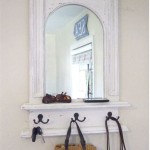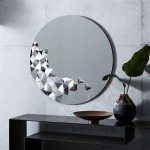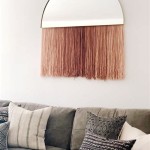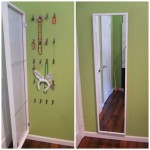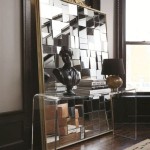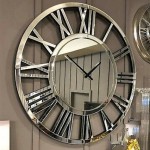How To Install A Bathroom Mirror
Installing a bathroom mirror can significantly enhance the aesthetic appeal and functionality of the space. This article provides a comprehensive guide on how to install a bathroom mirror safely and effectively. Proper planning, the right tools, and careful execution are crucial for achieving a professional-looking result.
Before commencing the installation process, it is essential to consider the type of mirror being installed. Options range from simple, unframed mirrors to more elaborate, framed models, including those with integrated lighting or storage. The installation method will vary depending on the mirror's design and weight.
Planning and Preparation
The first step in installing a bathroom mirror is meticulous planning. This involves accurately measuring the available space and determining the desired location for the mirror. Consider factors such as lighting, plumbing fixtures, and accessibility.
Accurate measurements are paramount. Use a measuring tape to determine the exact dimensions of the wall area where the mirror will be mounted. Mark the intended location using a pencil, ensuring the marks are level. A level is an indispensable tool for this stage, as even a slight deviation can lead to a skewed appearance.
Inspect the wall surface. The wall must be structurally sound and capable of supporting the weight of the mirror. For drywall, locate the wall studs using a stud finder. Securing the mirror to studs provides maximum stability. If studs are not in the ideal location, consider using drywall anchors designed to hold heavy objects. For tiled walls, special considerations are necessary, which will be addressed later in this article.
Gather all necessary tools and materials. Having everything readily available will streamline the installation process and minimize interruptions. Essential tools include:
- Measuring tape
- Pencil
- Level
- Stud finder
- Drill (with appropriate drill bits for the wall type)
- Screwdriver (or drill with screwdriver bits)
- Safety glasses
- Gloves
- Wall anchors (if needed)
- Mirror adhesive (optional, but recommended for added security)
- Clean cloths
In addition to the tools, ensure the appropriate mounting hardware is included with the mirror. If not, purchase suitable screws, brackets, or clips, depending on the mounting method specified by the manufacturer.
Installation Techniques
The installation technique will vary based on the specific type of mirror and the wall material. The following sections outline the common methods for different scenarios.
1. Installing a Mirror with Clips or Brackets: This is a common method for unframed mirrors. The mirror is held in place by clips or brackets that are attached to the wall. Carefully position the clips or brackets according to the manufacturer's instructions. Use a level to ensure they are aligned horizontally and vertically. Mark the screw locations on the wall, then pre-drill pilot holes. Secure the clips or brackets to the wall using screws, ensuring they are firmly attached. Gently slide the mirror into the clips or brackets, ensuring it is securely seated.
2. Installing a Framed Mirror with Hanging Wire or D-Rings: Framed mirrors often have a wire or D-rings on the back for hanging. Locate the studs in the wall and mark their positions. Use a level to determine the desired height for the mirror. Install a screw or hook into the stud at the marked height. Ensure the screw or hook is strong enough to support the weight of the mirror. Hang the mirror on the screw or hook, ensuring it is securely attached.
3. Installing a Mirror with Adhesive: This method is often used in conjunction with clips or brackets for added security, or for lightweight mirrors. Clean the back of the mirror and the wall surface with a clean cloth. Apply mirror adhesive to the back of the mirror in vertical beads. Press the mirror firmly against the wall, ensuring it is level. Use masking tape to hold the mirror in place while the adhesive cures, following the manufacturer's instructions for curing time.
4. Installing a Mirror on Tile: Installing a mirror on a tiled wall requires special care to avoid cracking the tiles. Use a diamond-tipped drill bit specifically designed for drilling through tile. Apply masking tape to the tile surface where the holes will be drilled to prevent chipping. Drill slowly and carefully, using light pressure. Once the drill bit has penetrated the tile, switch to a drill bit suitable for the wall material behind the tile. Proceed with the installation method appropriate for the mirror type.
Addressing Wall Anchor Challenges: When wall studs aren’t aligned with the desired mirror placement, wall anchors become necessary. Select anchors rated for the mirror's weight, erring on the side of caution. Toggle bolts offer superior holding power, while self-drilling anchors are convenient for lighter mirrors. Ensure the anchor is fully seated and tightened according to the manufacturer's instructions before hanging the mirror.
Regardless of the chosen installation method, exercise caution to prevent damage to the mirror or the surrounding wall. Wear safety glasses to protect your eyes from debris, and use gloves to protect your hands. If necessary, enlist the help of another person to hold the mirror in place during installation.
Safety Considerations and Finishing Touches
Safety is paramount during any home improvement project, and installing a bathroom mirror is no exception. Always wear safety glasses to protect your eyes from dust and debris. Consider wearing gloves to protect your hands from sharp edges and chemicals. If drilling into walls, be aware of the location of electrical wiring and plumbing to avoid causing damage or injury.
Before commencing the installation, turn off the power to any electrical circuits in the immediate area. This is particularly important if the mirror is equipped with integrated lighting. Use a voltage tester to ensure the power is off before working with electrical components.
After the mirror is installed, carefully inspect the installation to ensure it is secure and level. Clean the mirror surface with a glass cleaner to remove any smudges or fingerprints. Seal the edges of the mirror with caulk to prevent moisture from seeping behind the mirror. This is particularly important in humid environments like bathrooms.
Proper lighting is crucial for a bathroom mirror. Consider installing task lighting above or to the sides of the mirror to provide adequate illumination for grooming and other activities. Integrated lighting within the mirror frame can also be a stylish and functional option.
Addressing Common Installation Problems: Uneven walls can pose a challenge. Using shims behind mounting brackets can compensate for minor irregularities. For significant unevenness, consider applying a thin layer of patching compound to the wall to create a level surface before installation. When drilling into tile, start with a small pilot hole and gradually increase the size to prevent cracking.
Alternative Mounting Options: While screws and adhesive are the most common methods, alternative mounting options exist for specific situations. Heavy-duty suction cups can be used for temporary installations on smooth, non-porous surfaces. Magnetic mounting systems offer flexibility in positioning and are suitable for metal surfaces. Regardless of the chosen method, ensure it is capable of supporting the mirror's weight safely.
Maintaining and Cleaning Your Bathroom Mirror: Regular cleaning is essential to maintain the appearance of a bathroom mirror. Use a mild glass cleaner and a soft cloth to remove smudges and streaks. Avoid using abrasive cleaners, which can scratch the mirror surface. To prevent fogging, consider using an anti-fog spray or installing a heated mirror.
By following these steps and taking the necessary precautions, installing a bathroom mirror can be a straightforward and rewarding project. The result is a functional and aesthetically pleasing addition to the bathroom space.

How To Install A Mirror Without Frame Merrypad

Install A Recessed Vanity Mirror

How To Hang A Frameless Mirror On The Wall With Pictures

How To Install A Bathroom Vanity Mirror Light

Bathroom Mirror Frames 2 Easy To Install Sources A Diy Tutorial Retro Renovation

Diy Led Mirror Installation Personal Tips And Review

How To Frame Out That Builder Basic Bathroom Mirror For 20 Or Less

How To Install A Mirror Without Frame Merrypad

Install A Recessed Vanity Mirror

How To Frame A Mirror
